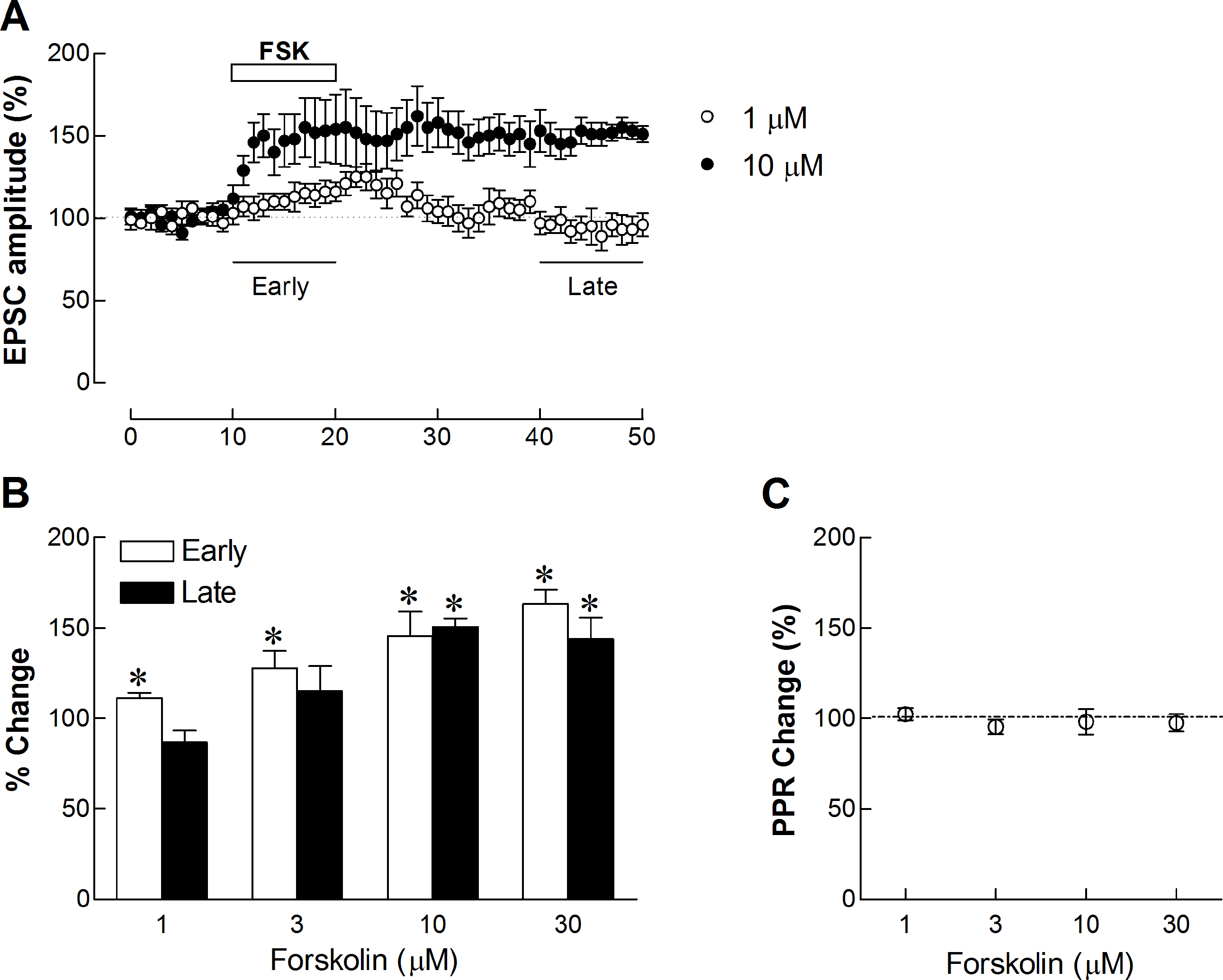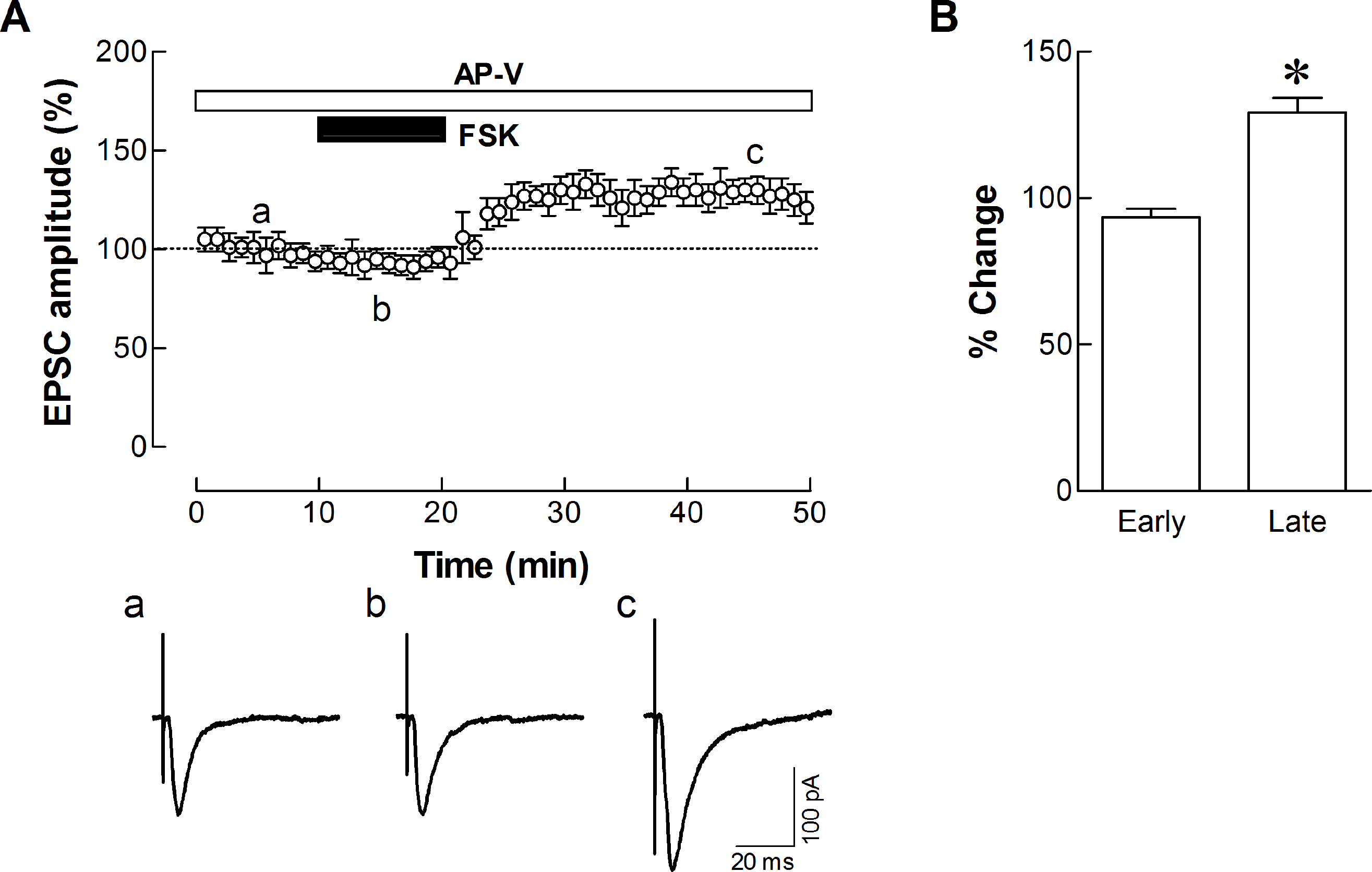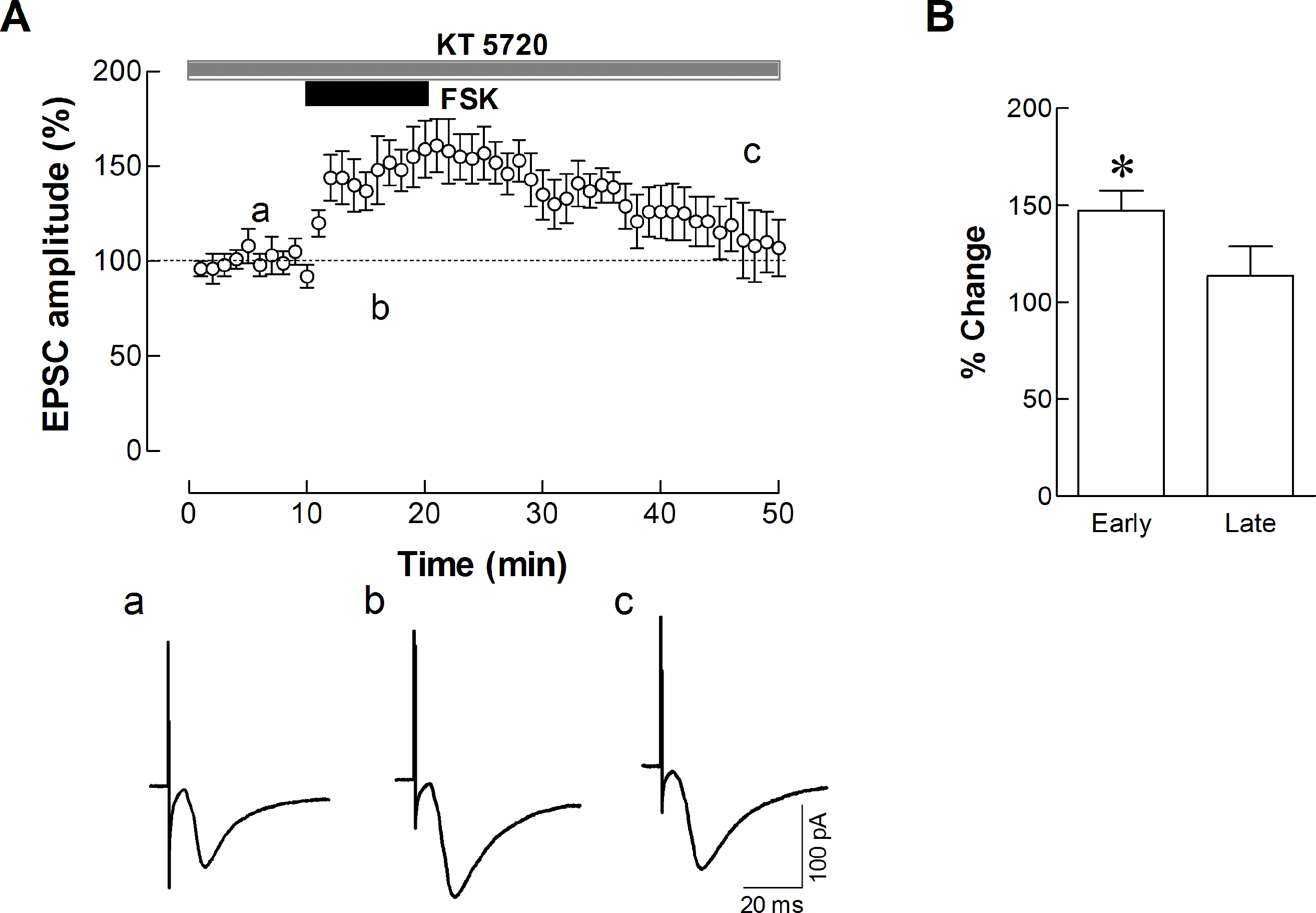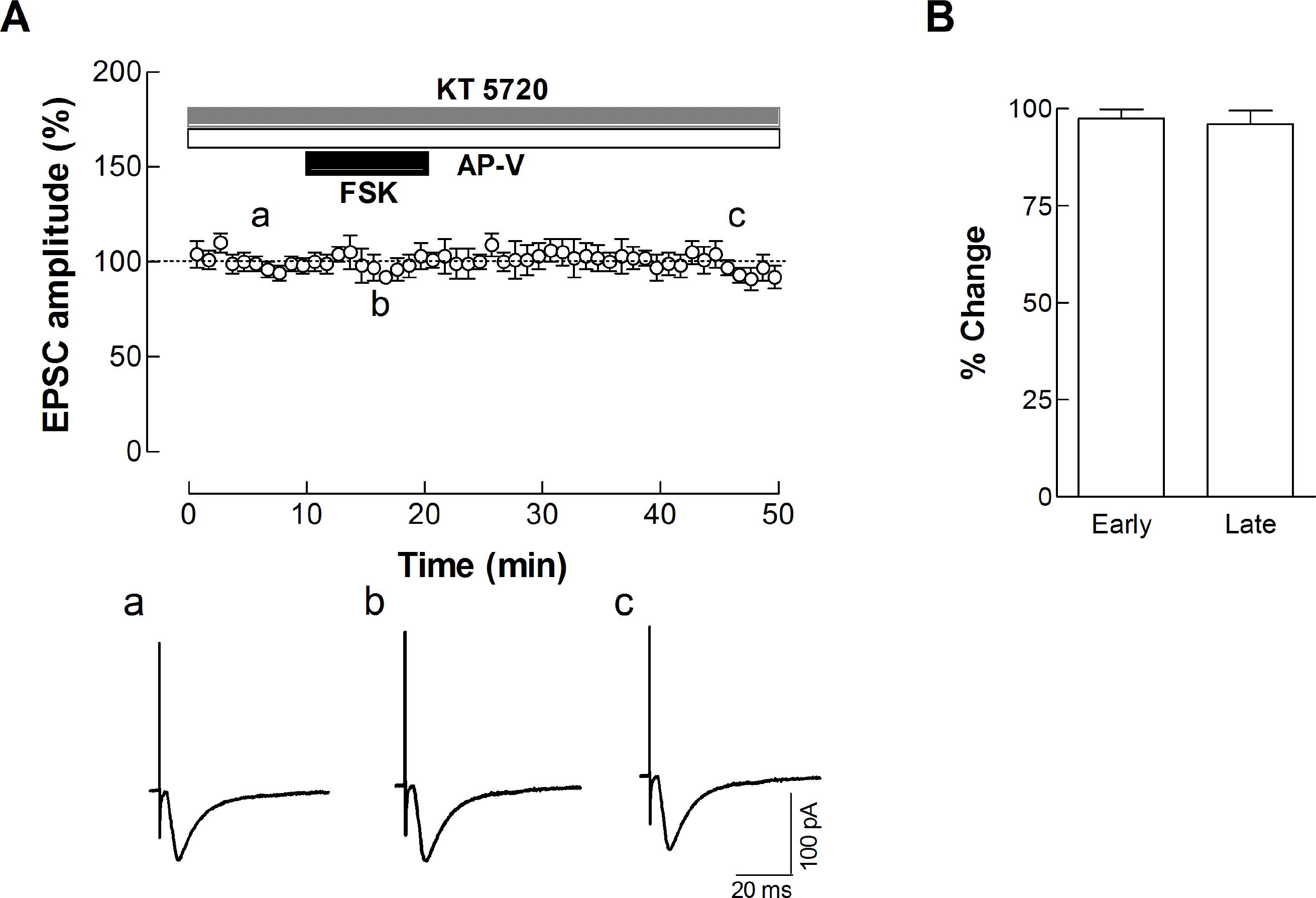Abstract
The effect of forskolin on corticostriatal synaptic transmission was examined by recording excitatory postsynaptic currents (EPSCs) in rat brain slices using the whole-cell voltage-clamp technique. Forskolin produced a dose-dependent increase of corticostriatal EPSCs (1, 3, 10, and 30 μM) immediately after its treatment, and the increase at 10 and 30 μM was maintained even after its washout. When the brain slices were pre-treated with (DL)-2-amino-5-phosphonovaleric acid (AP-V, 100 μM), an NMDA receptor antagonist, the acute effect of forskolin (10 μM) was blocked. However, after washout of forskolin, an increase of corticostriatal EPSCs was still observed even in the presence of AP-V. When KT 5720 (5 μM), a protein kinase A (PKA) inhibitor, was applied through the patch pipette, forskolin (10 μM) increased corticostriatal EPSCs, but this increase was not maintained. When forskolin was applied together with AP-V and KT 5720, both the increase and maintenance of the corticostriatal EPSCs were blocked. These results suggest that forskolin activates both NMDA receptors and PKA, however, in a different manner.
REFERENCES
Butler AK., Uryu K., Chesselet MF. A role for N-methyl-D-aspartate receptors in the regulation of synaptogenesis and expression of the polysialylated form of the neural cell adhesion molecule in the developing striatum. Dev Neurosci. 20:253–262. 1998.
Chavez-Noriega LE., Stevens CF. Modulation of synaptic efficacy in field CA1 of the rat hippocampus by forskolin. Brain Res. 574:85–92. 1992.

Chen C., Regehr WG. The mechanism of cAMP-mediated enhancement at a cerebellar synapse. J Neurosci. 17:8687–8694. 1997.

Cherubini E., Herrling PL., Lanfumey L., Stanzione P. Excitatory amino acids in synaptic excitation of rat striatal neurones in vitro. J Physiol. 400:677–690. 1988.

Cho HS., Choi SJ., Kim KJ., Lee HH., Cho YJ., Kim SY., Sung KW. Fluoxetine modulates corticostriatal synaptic transmission through postsynaptic mechanism. Korean J Physiol Pharmacol. 10:31–38. 2006.
Choi SJ., Kim KJ., Cho HS., Kim SY., Cho YJ., Hahn SJ., Sung KW. Acute inhibition of corticostriatal synaptic transmission in the rat dorsal striatum by ethanol. Alcohol. 40:95–101. 2006.

Colwell CS., Levine MS. Excitatory synaptic transmission in neostriatal neurons: regulation by cyclic AMP-dependent mechanisms. J Neurosci. 15:1704–1713. 1995.

Dalbem A., Silveira CV., Pedroso MF., Breda RV., Werne Baes CV., Bartmann AP., da Costa JC. Altered distribution of striatal activity-dependent synaptic plasticity in the 3-nitropropionic acid model of Huntington's disease. Brain Res. 1047:148–158. 2005.

Dessauer CW., Scully TT., Gilman AG. Interactions of forskolin and ATP with the cytosolic domains of mammalian adenylyl cyclase. J Biol Chem. 272:22272–22277. 1997.

Graybiel AM., Aosaki T., Flaherty AW., Kimura M. The basal ganglia and adaptive motor control. Science. 265:1826–1831. 1994.

Grey KB., Burrell BD. Forskolin induces nmda receptor-dependent potentiation at a central synapse in the leech. J Neurophysiol. 99:2719–2724. 2008.

Insel PA., Ostrom RS. Forskolin as a tool for examining adenylyl cyclase expression, regulation, and G protein signaling. Cell Mol Neurobiol. 23:305–314. 2003.
Jay TM. Dopamine: a potential substrate for synaptic plasticity and memory mechanisms. Prog Neurobiol. 69:375–390. 2003.

Jog MS., Kubota Y., Connolly CI., Hillegaart V., Graybiel AM. Building neural representations of habits. Science. 286:1745–1749. 1999.

Laurenza A., Sutkowski EM., Seamon KB. Forskolin: a specific stimulator of adenylyl cyclase or a diterpene with multiple sites of action? Trends Pharmacol Sci. 10:442–447. 1989.

Lu KT., Gean PW. Masking of forskolin-induced long-term potentiation by adenosine accumulation in area CA1 of the rat hippocampus. Neuroscience. 88:69–78. 1999.

Lu KT., Wu SP., Gean PW. Promotion of forskolin-induced long-term potentiation of synaptic transmission by caffeine in area CA1 of the rat hippocampus. Chin J Physiol. 42:249–253. 1999.
Otmakhov N., Khibnik L., Otmakhova N., Carpenter S., Riahi S., Asrican B., Lisman J. Forskolin-induced LTP in the CA1 hippocampal region is NMDA receptor dependent. J Neurophysiol. 91:1955–1962. 2004.

Ozawa S., Kamiya H., Tsuzuki K. Glutamate receptors in the mammalian central nervous system. Prog Neurobiol. 54:581–618. 1998.

Partridge JG., Tang KC., Lovinger DM. Regional and postnatal heterogeneity of activity-dependent long-term changes in synaptic efficacy in the dorsal striatum. J Neurophysiol. 84:1422–1429. 2000.

Picconi B., Pisani A., Barone I., Bonsi P., Centonze D., Bernardi G., Calabresi P. Pathological synaptic plasticity in the striatum: implications for Parkinson's disease. Neurotoxicology. 26:779–783. 2005.

Ronesi J., Lovinger DM. Induction of striatal long-term synaptic depression by moderate frequency activation of cortical afferents in rat. J Physiol. 562:245–256. 2005.

Rosenberg PA., Li Y. Forskolin evokes extracellular adenosine accumulation in rat cortical cultures. Neurosci Lett. 211:49–52. 1996.

Fig. 1.
Forskolin enhances corticostriatal EPSCs in a dose dependent manner. (A) Plot of average EPSCs data shows that forskolin increases EPSCs amplitude (1 and 10 μM). The bar above the plotted graph indicates the period of drug application. (B) Forskolin increases EPSCs amplitude in a dose-dependent manner. Graph shows the average EPSCs change during forskolin treatment (early phase), and after its treatment (late phase) at each concentration. Note that the effect of 10 and 30 μM forskolin was maintained even after its washout. (C) Graph shows the average PPR change by forskolin. ∗p<0.05 when compared to baseline EPSCs.

Fig. 2.
Early effect of forskolin needs NMDA receptor activation. (A) Plot of average EPSCs data shows that treatment of AP-V (100 μM), an NMDA receptor antagonist, blocks the early effect of forskolin (10 μM). However, after washout of forskolin, EPSCs still increase. The bar above the plotted graph indicates the period of drug application. Representative traces of EPSCs before (a), during (b), and after (c) forskolin treatment. (B) Column graph shows the average EPSCs data. ∗p<0.05 when compared to baseline EPSCs.

Fig. 3.
Late enhancement of corticostriatal synaptic transmission by forskolin requires PKA activity. (A) Plot of average EPSCs data shows that intracellular application of KT 5720 (5 μM), a PKA inhibitor, does not affect the early increase by forskolin (10 μM), but blocks the late effect. The bar above the plotted graph indicates the period of drug application. Representative traces of EPSCs before (a), during (b), and after (c) forskolin treatment. (B) Column graph shows the average EPSCs data. ∗p<0.05 when compared to baseline EPSCs.

Fig. 4.
Forskolin exerts no effect on corticostriatal synaptic transmission when both NMDA receptor and PKA activation are blocked. (A) Plot of average EPSCs data shows that the effect of forskolin (10 μM) on corticostriatal synaptic transmission was blocked when AP-V (100 μM) and KT 5720 (5 μM) were applied together. The bar above the plotted graph indicates the period of drug application. Representative traces of EPSCs before (a), during (b), and after (c) forskolin treatments. (B) Column graph shows the average EPSCs data.





 PDF
PDF ePub
ePub Citation
Citation Print
Print


 XML Download
XML Download